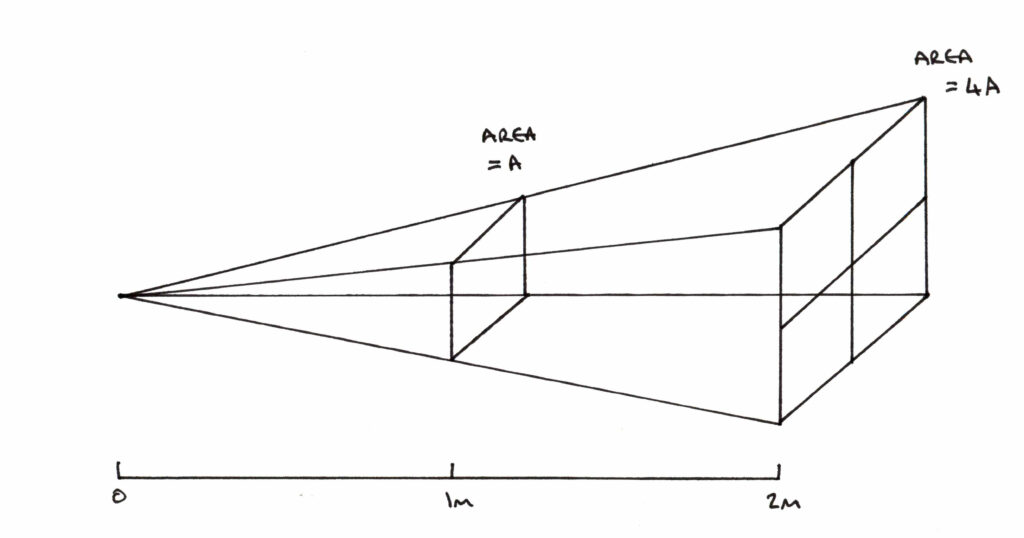There is much debate at the moment about the different risks posed by being 1 or 2 metres away from a potential source of danger.
However, understanding the effects of distance in a noise induced hearing loss case can be the difference between success and failure for either side.
In my recent article What is ‘Noise’ in NIHL claims? I set out how the logarithmic nature of the decibel scale meant that each decrease/ increase of 3 dB results in a halving/ a doubling of the sound pressure.
By combining that knowledge with the “Inverse Square Law” it can be understood that a doubling of the distance from a source of noise results in a 6 dB decrease in noise exposure.
The Inverse Square Law

As can be seen from the diagram, if an individual is standing 1 metre away from the source of noise the noise disperses over an area which in the diagram is designated as “A”.
If the distance is doubled – the area over which the noise is dispersed not by 2x the area of “A” but by 4x the area of “A”.
The result is that there is only one quarter of the noise at double the distance. A quarter is the same as reducing a noise level by half (or 3 dB) and then halving again (a further 3 dB). The total reduction in noise exposure is 6 dB.
Taking this further if the distance were to be increased tenfold the magnitude is reduced to 1/100th of the original which is a 20 dB reduction.
Example in a NIHL claim
There are two workers who work near each other with a single source of noise to which they are exposed.
The first works 1.5m from the source and the second works 3m from it.
The noise measured at the first worker’s ear (at 1.5m) is calculated by an engineer to be 90 dB (A) lep,d.
The second worker (at 3m) will have a 6 dB reduction, so resulting in an 84 dB (A) lep,d exposure.
It follows that the first worker may be potentially successful in his/ her claim but the second worker would be unlikely to be successful.
This small, but important, detail would affect the overall result of the claim.
In Practice
Of course, in the real world cases are rarely as simple as the example.
Practitioners are likely to feel uncomfortable about making firm decisions on breach of duty based upon the Inverse Square Law alone.
However, it does highlight the need for accurately assessing the distances from the source(s) of noise in NIHL cases.
Often it may be difficult for practitioners to come to a firm conclusion as to the success or otherwise of a case based on the maths alone. However, there are cases where the distances involved are so short as to make no difference. There are others where the distances are so long that the noise levels will clearly have dropped considerably.
Engineering evidence and witness evidence
What the Inverse Square Law does demonstrate though is how important it is for engineers to be given accurate evidence as to the sources of noise and how far individuals are away from them.
If there is a significant discrepancy between witness evidence as to the distance from noise sources and the reality, then the resulting engineering evidence will be inaccurate.
Likewise, if there is no evidence as to the distance from the noise source(s), the Claimant may be left in limbo. The engineer may be unable to comment either way or may attempt to estimate the distance.
Such an estimate may be accurate if the engineer is well acquainted with the source of noise and role involved. In other cases such an estimate may be significantly inaccurate.
Of course this could favour either the claimant or the defendant depending on whether the engineer’s estimate is more generous or less generous as to the distance from the source of noise.
NIHL cases require a number of matters to be considered, and the distance from noise sources is one of them.
Part 35 Questions
All of the above clearly shows that an accurate distance from the source of noise to the claimant’s ears needs to be established.
Depending on the circumstances, the evidence and what the engineer says in his or her report, Part 35 questions may need to be asked to clarify the evidence concerning the effects of the distance on the noise levels. It may be the difference between either side winning or losing a case.
Practice points
The above demonstrates that it is vital in NIHL cases that:
- The distance is confirmed between the source(s) of noise and the claimant’s ear.
- In the absence of any distance the engineer either may not be able to comment at all, or be forced to estimate. This may, or may not, be accurate and may advantage one party or the other.
- Detailed analysis of the evidence and the engineering report may show that Part 35 questions are required.